Related Research Articles
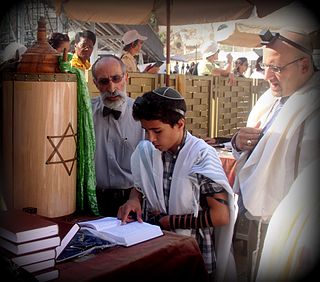
Bar mitzvah and bat mitzvah refer to the Jewish coming of age ritual. The plural is b'nei mitzvah for both boys and mixed gender groups, or b'not mitzvah for girls. B'mitzvah, Simchat Mitzvah, or other non-gendered terms are used for nonbinary teens, materials intended to be inclusive of all genders, and those who wish to minimize gendered language in their service.
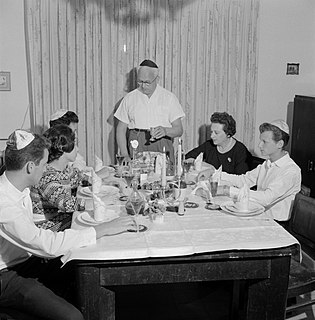
Kiddush, literally, "sanctification", is a blessing recited over wine or grape juice to sanctify the Shabbat and Jewish holidays. Additionally, the word refers to a small repast held on Shabbat or festival mornings after the prayer services and before the meal.

Kosher wine is wine that is produced in accordance with halakha, and more specifically kashrut, such that Jews will be permitted to pronounce blessings over and drink it. This is an important issue, since wine is used in several Jewish ceremonies, especially those of Kiddush.

Challah is a special bread of Ashkenazi Jewish origin, usually braided and typically eaten on ceremonial occasions such as Shabbat and major Jewish holidays. Ritually acceptable challah is made of dough from which a small portion has been set aside as an offering. Challah may also refer to the dough offering. The word is biblical in origin, though originally referred only to the dough offering. Similar braided breads such as kalach and vánočka are found across Eastern Europe.

Jewish cuisine refers to the worldwide cooking traditions of the Jewish people. During its evolution over the course of many centuries, it has been shaped by Jewish dietary laws (kashrut), Jewish festivals and holidays, and traditions centred around Shabbat. Jewish cuisine is influenced by the economics, agriculture, and culinary traditions of the many countries where Jewish communities have settled and varies widely throughout the entire world.
A seudat mitzvah, in Judaism, is an obligatory festive meal, usually referring to the celebratory meal following the fulfillment of a mitzvah (commandment), such as a bar mitzvah, bat mitzvah, a wedding, a brit milah, or a siyum. Seudot fixed in the calendar are also considered seudot mitzvah, but many have their own, more commonly used names.
Sheva Brachot literally "the seven blessings" also known as birkot nissuin, "the wedding blessings" in Jewish law are blessings that are recited for a bride and her groom as part of nissuin. In Jewish marriages there are two stages: betrothal (erusin) and establishing the full marriage (nissuin). Historically there was a year between the two events, but in modern marriages, the two are combined as a single wedding ceremony.
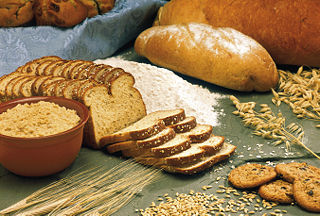
Birkat Hamazon, known in English as the Grace After Meals, is a set of Hebrew blessings that Jewish law prescribes following a meal that includes at least a kezayit (olive-sized) piece of bread. It is a understood as a Biblical Commandment based on Deuteronomy 8:10.
Seudah shlishit or shaleshudes (Yiddish) is the third meal customarily eaten by Sabbath-observing Jews on each Shabbat. Its name shaleshudes is an elided form of šālōš sǝʿuddôt. Both names refer to the third of the three meals a Jew is obligated to eat on Shabbat according to the Talmud.
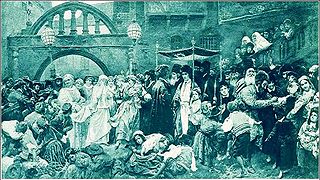
A Jewish wedding is a wedding ceremony that follows Jewish laws and traditions. While wedding ceremonies vary, common features of a Jewish wedding include a ketubah which is signed by two witnesses, a chuppah or huppah, a ring owned by the groom that is given to the bride under the canopy, and the breaking of a glass.
In Judaism, a berakhah, bracha, brokho, brokhe is a formula of blessing or thanksgiving, recited in public or private, usually before the performance of a commandment, or the enjoyment of food or fragrance, and in praise on various occasions.

Berakhot is the first tractate of Seder Zeraim of the Mishnah and of the Talmud. The tractate discusses the rules of prayers, particularly the Shema and the Amidah, and blessings for various circumstances.
The Seudat Chiyat HaMatim, a Hebrew term, is a Seudah (feast) for the righteous following the Chiyat Hamatim, the bodily Resurrection of the dead, which is referred to in a passage of the Talmud in the section on Passover which alludes to a relationship between the Passover Seder and this other feast of life and freedom. Rabbi Avira interpreted the biblical passage

Israeli cuisine comprises both local dishes and dishes brought to Israel by Jews from the Diaspora. Since before the establishment of the State of Israel in 1948, and particularly since the late 1970s, an Israeli Jewish fusion cuisine has developed.

A challah cover is a special cloth used to cover the two braided loaves (challah) set out on the table at the beginning of an Ashkenazi Shabbat or Yom Tov meal. While its appearance lends a decorative and ceremonial aspect to the set table, its presence serves both a halakhic and symbolic function.

Rosh HaShanah is the Jewish New Year. The biblical name for this holiday is Yom Teruah, literally "day of shouting or blasting." It is the first of the Jewish High Holy Days, as specified by Leviticus 23:23–25, that occur in the late summer/early autumn of the Northern Hemisphere. The High Holy Days comprise both Rosh HaShanah and Yom Kippur.
A bentcher,birchon or birkon is a booklet of prayers based around a particular event such as the Jewish sabbath. The most common form is Birkat Hamazon often titled סדר ברכת המזון - Seder Birkat Hamazon in Hebrew. Some editions actually have the Birkat Hamazon prayer in the back, appearing almost as an afterthought. Bentchers are commonly known as birchonim in Modern Hebrew and Sephardic communities.

Erusin is the Hebrew term for betrothal. In modern Hebrew, "erusin" means engagement, but this is not the historical meaning of the term, which is the first part of marriage.
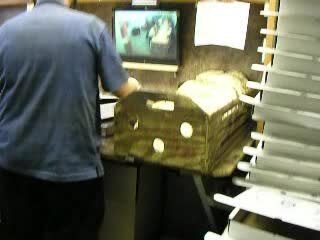
In Judaism, the dough offering is a positive commandment requiring the owner of a bread dough to give a part of the kneaded dough to a kohen. The obligation to separate the dough offering from the dough begins the moment the dough is kneaded, but may also be separated after the loaves are baked. This commandment is one of the twenty-four kohanic gifts, and, by a biblical injunction, is only obligatory in the Land of Israel, but from a rabbinic injunction applies also to breadstuffs made outside the Land of Israel.
Ethiopian Jewish cuisine is the cuisine of the Beta Israel. The cuisine of the Ethiopian Jews is similar to the cuisine of other Ethiopians, with some variations.
References
- ↑ Aish: Guide to Jewish Wedding
- ↑ Roden, Claudia (1997). The Book of Jewish Food . ISBN 9780394532585.
- ↑ Marks, Gil (2010). Encyclopedia of Jewish Food. pp. 70–71.
- ↑ Jewish Wedding Photography: Blessing of the Challah
- ↑ Documents And Designs: Jewish Wedding Program Templates
- ↑ Joseph Judah Chorny, Sefer HaMassa'ot, 1884 (published posthumously)
- ↑ Abraham Danzig, Chayei Adam (Wisdom of Man) 129:4
- ↑ USCCB Tobit 7:12-14
- ↑ USCCB Genesis 24:54
- ↑ Biblehub: John 2:1-11
- ↑ Biblehub: Rev. 19:9
- ↑ Sefaria: Sanedrin 59b
- ↑ Jewish Encyclopedia: Leviathan and Behemoth
- ↑ CCC 2618
- ↑ CCC 1617